Thanks!
Thanks for the many interesting and insightful comments at yesterday’s blog post.
|
|
|
2024 Homer/Kachemak Bay Bald Eagle IPTs
IPT #1: WED 21 FEB 2024 through the full day on SUN 25 FEB 2024. Five full days/20 hours on the boat: $5500.00. Limit 5 photographers/Openings: 1.
IPT #2: MON 26 FEB 2024 through the full day on FRI 1 MAR 2024. Five full days/20 hours on the boat: $5500.00. Limit 5 photographers. Limit 5 photographers/Openings: 1.
Register for both trips to maximize your travel dollars and enjoy a $1000 discount while you are at it.
This trip features non-stop flight photography as well as many opportunities to create both environmental and point-blank portraits and head shots of one of North America’s most sought-after avian subjects: Bald Eagle (Haliaeetus leucocephalus). Other reliable subjects will include Sea Otter, Glaucous-winged and Short-billed (formerly Mew) Gulls.
In addition, we should see (and possibly get to photograph) Common Murre, Pigeon Guillemot, Pelagic Cormorant, two or three species of loons, and a smattering of ducks including two species of merganser, all three scoters, Common and Barrow’s Goldeneyes, Bufflehead, Harlequin, and Long-tailed Ducks. Close-range photographic chances for these species will require some luck. Some of these species, especially when in flocks, can, however, often be used effectively when pleasing creating bird-scapes. In most years we have chances for Short-eared and Great Grey Owl, Grey-crowned Rosy Finch, and Moose in and around Homer.
You will enjoy working with the best and most creative boat captain in Homer on his sturdy, photography-spacious, seaworthy, open-deck watercraft.
There will be only five photographers (not the usual six), plus the leader on these trips.
Almost endless small group Photoshop, Image Review, and Image Critiquing sessions.
If we need to be out early, we will be the first boat out. If the conditions are great, we will stay out. And when there is a chance for sunset silhouettes, we will be in the right spot at the right time. And ad we will be traveling through gorgeous wilderness country, landscape and scenic opportunities abound.
Also featured is a professional leader, often referred to as the world’s most knowledgeable bird photography trip leader and instructor. He is conversant in Canon, Nikon, and Sony. You will learn practical and creative solutions to everyday photographic problems. You will learn to see the shot, to create dynamic images by fine-tuning your compositions, to best utilize your camera’s AF system, and how to analyze the wind, the sky conditions, and the direction and quality of the light. This is one of the very few trips Homer trips available where you will not be simply put on the birds and told to have fun. You will learn to be a better photographer.
Homer 2022 Bald Eagle Highlights and Handholding Compositional Tips by Arthur Morris/BIRDS AS ART
Enjoy and be inspired by just a few Homer Bald Eagle highlight images. Hand holding intermediate telephoto lens will always yield slightly different compositions. Learn more about that topic in this short (3:14) video.
|
|
All images from Kachemak Bay in 2022! |
What You Will Learn
You will learn practical and creative solutions to everyday photographic problems. You will learn to see the shot, to create dynamic images by fine-tuning your compositions, to best utilize your camera’s AF system, and how to analyze the wind, the sky conditions, and the direction and quality of the light. This is one of the very few trips Homer trips available where you will not be simply put on the birds and told to have fun. You will learn to be a better photographer. But only if that is what you want.
You will learn to get the right exposure when it is sunny, when it cloudy-bright, when it is cloudy, when it is cloudy-dark, or when it is foggy. Not to mention getting the right exposure when creating silhouettes. You will learn to make pleasing blurs and to create silhouettes working in Shutter Priority mode when the situation is right. Most importantly you will learn to pick your best flight images from tens of thousands of images.
|
|
All images from Homer or Kachemak Bay, AK |
What’s Included
One four hour or two two-hour boat trips every day (weather permitting), all boat fees and boat-related expenses (excluding tips), ground transportation to and from the dock and back to the hotel each day, in-the-field instruction and guidance, pre-trip gear advice, small group post-processing and image review sessions, and a thank you dinner.
What’s Not Included
Your airfare to and from Homer, AK (via Anchorage), the cost of your room at Land’s End Resort, all personal items, all meals and beverages, and a tip for the boat captain.
Please Note
On great days, the group may wish to photograph for more than four hours. If the total time on the boat exceeds 20 hours for the five-day trips the group will share the additional expense at a rate of $225/hour. The leader will pay for the bait.
Some folks may wish to rent their own vehicle to take advantage of local photographic opportunities around Homer. In 2023 those included Moose, Great Grey, and Short-eared Owls.
Deposit Information
A $3000 non-refundable deposit/trip is required. You may pay your deposit with credit card or by personal check (the latter made out to BIRDS AS ART) and sent via US mail only to Arthur Morris. PO Box 7245. Indian Lake Estates, FL 33855. Your balance, due 60 days before the date of departure, is payable only by check (as above).
In Closing
I have been going to Homer off and on for close to two decades. Every trip has been nothing short of fantastic. Many folks go in mid-March. The earlier you go, the better the chances for snow. The only way to assure that you are on the best of these two trips is to sign up for both of them. Can you keep up with me? If you have any questions, or are good to go for one, or two of these great trips, please let me know via e-mail or give me a call on my cell phone at 863-221-2372.
Via Comment by Bob Eastman
Happy Thanksgiving Sir. Anyone looking for an amazing time, get to Homer with artie. There is so much to see. Not to mention hundreds and hundreds of Bald Eagles so close. To see them up close and personal is truly something to behold; portraits and flight are a given and you name, and it is there.
Always with love b
|
|
|
This image was created on 27 February 2023 on an Instructional Photo-Tour at Kachemak Bay, Homer, AK. I used the handheld Sony FE 70-200mm f/2.8 GM OSS II lens with the Sony FE 1.4x Teleconverter (at 223mm) and The One, the Sony Alpha 1 Mirrorless Digital Camera.. The exposure was determined via Zebras with ISO on the rear dial. ISO 500: 1/3200 sec. at f/4 (wide open) in Manual mode. AWB at 3:55:18pm on a sunny afternoon. Tracking: Zone/AF-C with Bird-Eye/Face Detection performed well enough. Click on the image to enjoy a high-res version. Image #1: Bald Eagle starting dive |
Headless Birds?
Can an image of a bird be successful if you cannot see its head and its eye (or eyes)? Do you like this one or would it be an insta-delete for you?
|
|
Image #2: The Photo Mechanic screen capture for the Glaucous-wing Gull flying in front of the reflection muted sun image |
2,961,500 Over-exposed Pixels
Would you delete this one? Why? Or is it possible to successfully optimize an image with nearly 3 million over-exposed pixels (albeit out of 51 million)?
Bright Sun Image Capture Difficulties
Unless the sun is very well muted, including it (or its reflection) in the frame will almost always result in millions of over-exposed pixels. The problem is unavoidable. If you expose so as to avoid over-exposing the sun (or its reflection), everything else — be it sky or water, will be rendered black. No matter how you meter or how you set your exposure, the case is closed.
|
|
|
This image was created on 22 February 2022 on an Instructional Photo-Tour at Kachemak Bay, Homer, AK. I used the handheld Sony FE 200-600mm f/5.6-6.3 G OSS lens (at 559mm) and The One, the Sony Alpha 1 Mirrorless digital camera. ) The exposure (for images with red sky backgrounds) was determined using Zebra technology with Exposure Compensation on the Thumb Dial. Shutter Priority +1.7 stops. AUTO ISO set ISO 320: 1/2000 second at f/6.3 (wide-open) in Manual Mode. AWB at 6:44:29pm on a mostly sunny afternoon. RawDigger showed the exposure to be perfect. Tracking: Zone/AF-C with Bird Face/Eye Detection performed perfectly. Be sure to click on the image to enjoy a high-res version. Image #2A: Glaucous-wing Gull flying in front of the reflection of a somewhat muted sun
|
The Optimized Image
Even with the Exposure slider pulled down 2/3 stop, the White slider at -100, and the Highlight Slider set to -100, the reflection of the sun in the water was massively over-exposed. What to do? Replace the over-exposed pixels by any means. The big key was trying Content-Aware Fill. I was shocked at how successful that approach was. After that, it was a matter of using the Clone Stamp Tool, the new Remove Tool, and then smoothing everything with a Layer of Gaussian Blur painted in as needed after the addition of a Hide-all (Black, or Inverse) Layer Mask.
Your Call?
Like it or hate it?
Typos
With all blog posts, feel free to e-mail or to leave a comment regarding any typos or errors.

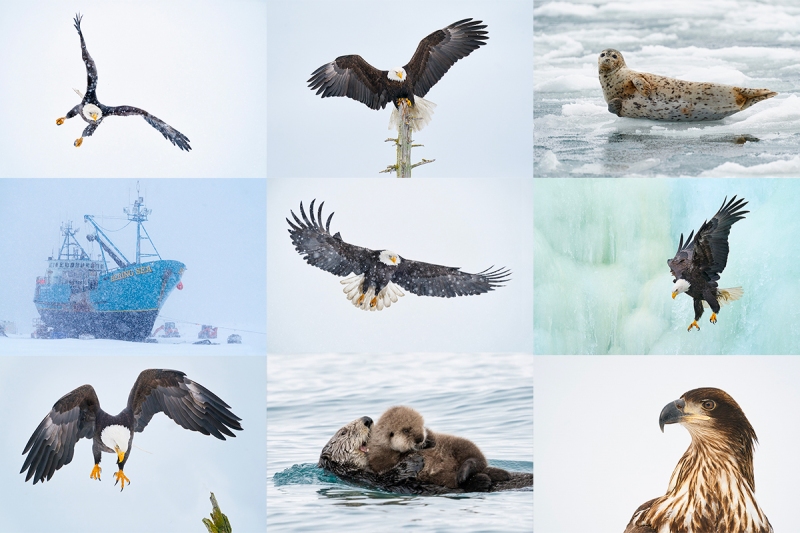
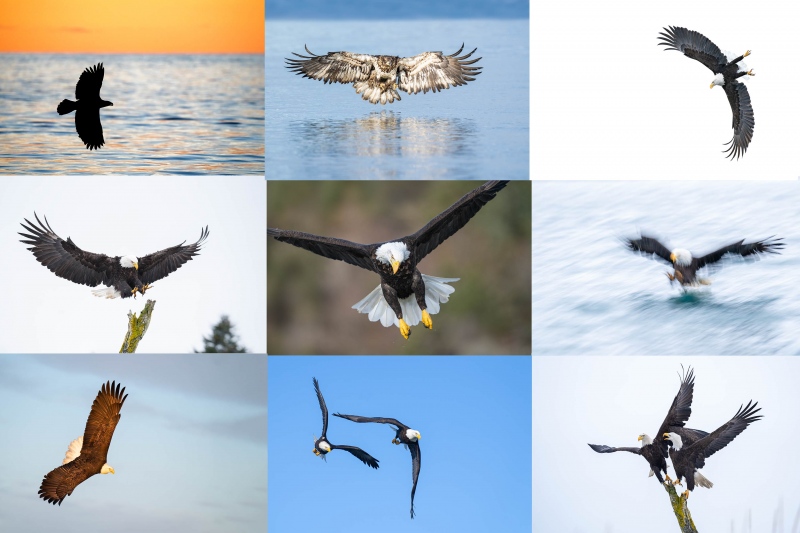
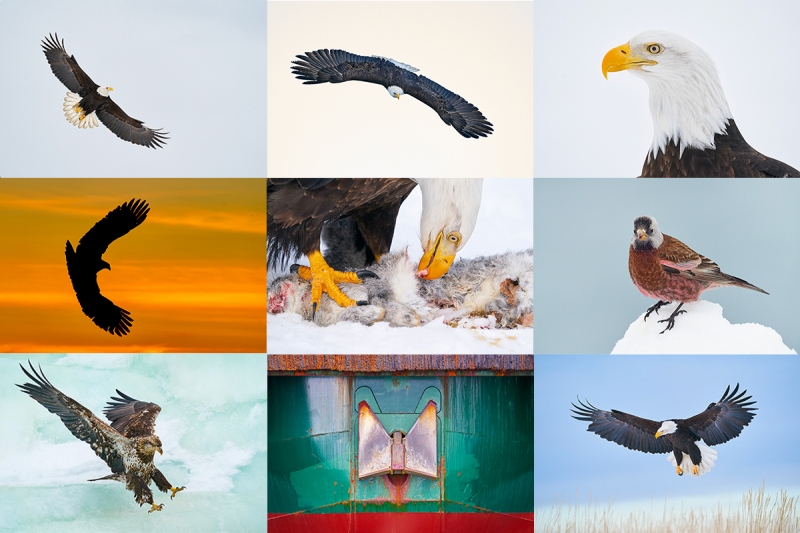
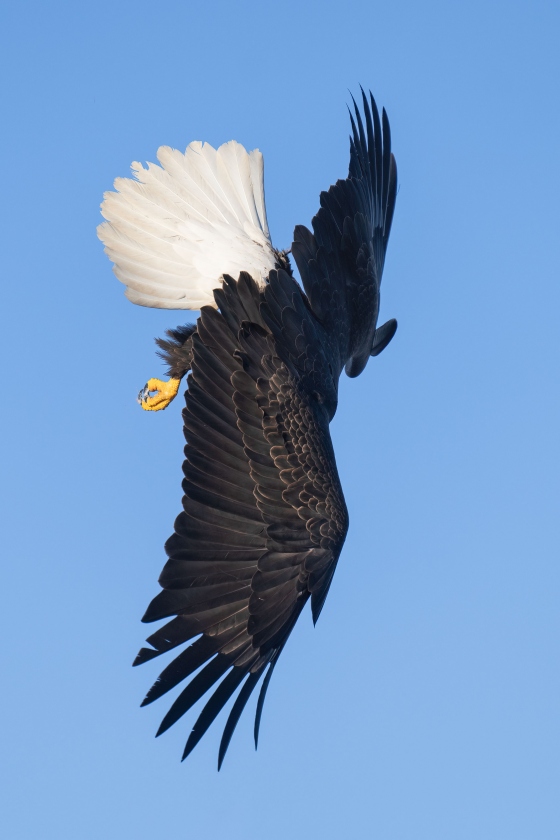
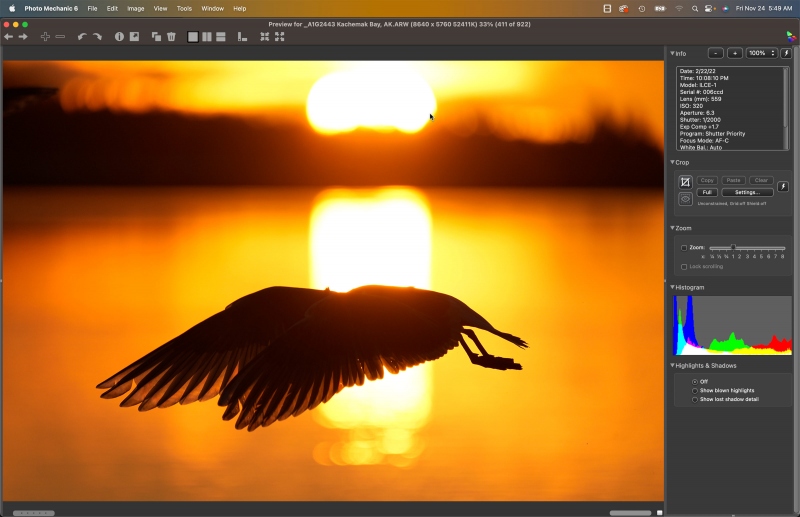
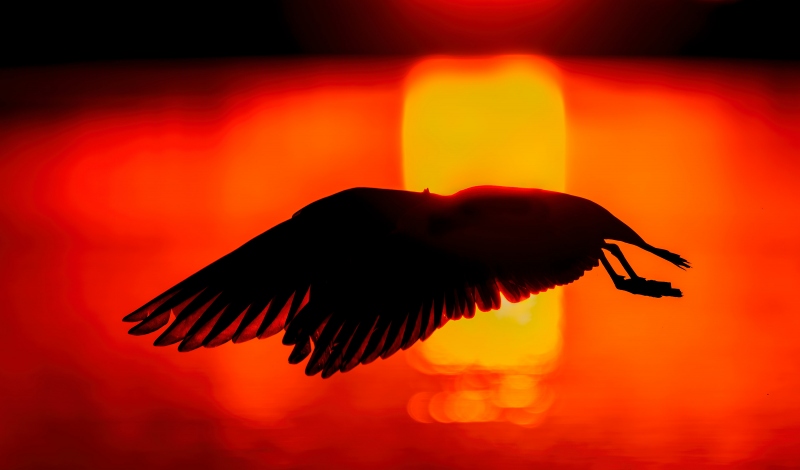













I think the only reason that I would hold on to these images would be in the event I needed to clone a winglet or some other component. Otherwise, hit delete.
Thanks for commenting Adam. When I save images as source material, they need to be from a series of similar images. I like both images, the first for great look at the dorsal surface of the near-wing and the great spread tail, and the second for bold colors and the fact that I learned a lot while optimizing it.
with love, a
ps: remember though, you need to ask yourself, “What the heck does he know?”
Artie,
The silhouetted bird in your picture looks like a gull to me, not a Bald Eagle. Lots of specifics about this, but probably the easiest give away on this is the tiny little hallux visible in the silhouette which would be a big, strong hallux in a Bald Eagle.
Ryan
Hey Ryan,
You have eagle eyes! Great catch. I was not sure that you were correct until I lightened the image. Many thanks, artie
No problem at all! I’ve studied many gulls recently and those primaries screamed gull to me when I first looked.
I hear you. My brain failed to engage as there were a dozen or more eagle silhouettes before and after this one. You could call it a Bald Eagle mindset.
thanks again, a